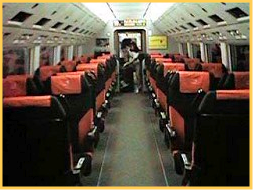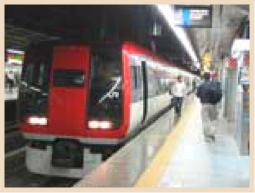
Todd Jay Leonard, Blog


I remember arriving in Tokyo on my first trip outside the USA as a 17-year-old exchange student and just being absolutely awestruck at everything. The whole caboodle was so foreign, naturally, but to this small-town kid from Indiana, it went beyond that. I was embarking upon an adventure of a lifetime that would eventually have a great influence upon my future life and career.
Of course, I didn't know that then. At that moment, all I could think about was, "Wow! I'm in Japan."
Adding to the excitement was the fact that the '70s disco group "Peaches and Herb" were on our plane and happened to be in the immigration line with us. Of course we all got autographs and snapped rolls of film, commemorating this brush with fame.
I was reminded of this experience when a reader recently wrote to ask about what places I recommend visiting while in Japan. This is her first trip abroad, and, definitely, she will be visiting Japan's equivalent of the "Big Apple." She wants some inside information on how to get around, where to stay, eat, tour, and shop in Tokyo.
So, get out your scissors to clip this one for future reference, if you're entertaining the idea of traveling to this side of the Pacific Ocean and visiting the "land of the rising sun."
First and foremost, doing Japan on your own is admirable, but can be quite daunting for the first-time visitor. Of course, 2007 is a far cry from 1979, but it can still give a first-time visitor a run for his/her money.
Immediately upon arriving at Tokyo's Narita Airport, travelers are met with a cacophony of sights and sounds that sometimes leave them speechless. The immense size and the volume of people coming and going in all directions in the terminal can be jarring to the uninitiated.
Today, it is a very modern and international airport with signs in English to help guide you. When I first came to Japan, there were no Romanized or English signs, except for the sign guiding travelers to immigration. A green and black lighted sign had the word "ALIEN" in huge letters. It seemed so odd to me that I was compelled to snap a photo of it.
Fortunately, those signs have been replaced with more tasteful ones that don't make visitors feel so unwelcome or like creatures from outer space. In fact, since that time, Japan has done remarkably well in incorporating easy to understand directions and signs for visitors with no command of the Japanese language.
From the airport to downtown Tokyo is quite a jaunt. I do not recommend jumping into a taxi for the nearly two-hour trip unless you have $200 burning a hole in your pocket.
Besides, if time is a factor, the express train from the airport to Tokyo Station is much faster anyway because one never knows what kind of traffic is waiting on the expressway between the airport and central Tokyo.
For a reasonable fare, it is easy to hop on the "Narita Express" train that takes you to the heart of Tokyo. There are several other train options, which are cheaper, but some are local trains that have many stops and others end at stations that are not as convenient.
The trains are clean, comfortable and efficient, which makes the trip quite enjoyable and hassle-free. There is also a limousine bus service from the airport to a variety of destinations in and around Tokyo, but one has to take into account that pesky traffic that can sometimes make the normally 90-minute trip into one that takes several hours.
I highly recommend arranging hotel accommodations before arriving in Tokyo. There are literally thousands of hotels - in all price ranges - but getting a room on demand can be a bit sticky if it is during high season or coincidentally corresponds with a big event taking place in Tokyo.
For the high-end visitor who is not on a budget, there are exceptional hotels that can make a person feel like royalty ... but you need a princely purse to pay for it. The Park Hyatt was the hotel featured in the film "Lost in Translation," and it has one of the best reputations for service and amenities.
For the discriminating but cash-conscious traveler, one can find suitable accommodations at reasonable rates (for Tokyo) costing $60 to $100 per person per night. In Japan, western-style and traditional-style hotels charge per person and not per room.
So, if a couple wants to reserve a room, they would pay a "twin-rate" and usually be given a room with two twin beds. Many budget hotels in Japan exclusively have either single rooms or twin rooms. Hotels that cater to foreign guests will sometimes have double or queen-sized beds, but the charge is still per person and not per room.
I think the average Japanese couple prefers separate beds, unlike Americans who often prefer to have one big bed. When my mother and stepfather came to visit, a friend reserved their hotel for them in Tokyo. He assumed, because of their age, they would want to have twin beds (like Japanese married couples). It surprised them to see two twin beds, instead of two double or queen-sized beds, which is more standard in the United States.
I have several hotels that I routinely use when on business in Tokyo. These fall into the category of "business hotel," which means the rooms are small, compact, but clean. These hotels, as the name suggests, cater to businesspeople that basically need a comfortable and convenient place to sleep without the frills of more higher-priced hotels (bellhops, room-service, valet service).
The traditional Japanese inn, or "ryokan," is a nice choice for visitors who want to experience traditional Japan. The prices tend to be as expensive, or more so, as Western-style hotels, but a Japanese breakfast is often included in the price.
The rooms are covered with "tatami" mats, so no shoes are permitted inside; and guests sleep on "futon" on the floor. These rooms usually have a low table with cushions, but often no chairs are provided. Sometimes, only a toilet is a part of the room, with guests using a traditional Japanese-style communal bath for bathing. Most ryokan in Tokyo, however, tend to offer both - a full bath in each room and the option of bathing in a communal bath on the main floor. Guests are given cotton "yukatta" (robe) and slippers to use while at the hotel.
In my next column, I will write about what to do in Tokyo, and the best way to do it.

By TODD JAY LEONARD
Columnist
Adventure of a lifetime
Former exchange student recalls first visit to Japan
Monday, February 26 , 2007







